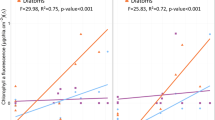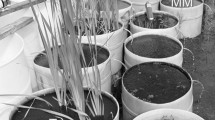Abstract
Pesticides may enter water bodies in areas with a high proportion of agricultural land use through surface runoff, groundwater discharge, and erosion and thus negatively impact nontarget aquatic organisms. The herbicide atrazine is used extensively throughout the Midwest and enters the Mississippi River through surface runoff and groundwater discharge. The purpose of this study was to determine the extent of atrazine contamination in Louisiana’s estuaries from Mississippi River water under different flow and nutrient regimes (spring and summer) and its effect on the biomass and oxygen production of the local phytoplankton community. The results showed that atrazine was consistently present in these systems at low levels. Microcosm experiments exposed to an atrazine-dilution series under low and high nutrient conditions to determine the phytoplankton stress response showed that high atrazine levels greatly decreased phytoplankton biomass and oxygen production. Phytoplankton exposed to low and moderate atrazine levels under high nutrient conditions were able to recover after an extended acclimation period. Communities grown under high nutrient conditions grew more rapidly and produced greater levels of oxygen than the low nutrient treatment groups, thus indicating that atrazine exposure may induce a greater stress response in phytoplankton communities under low-nutrient conditions. The native community also experienced a shift from more sensitive species, such as chlorophytes, to potentially more resilient species such as diatoms. The phytoplankton response to atrazine exposure at various concentrations can be especially important to greater trophic levels because their growth and abundance can determine the potential productivity of the entire ecosystem.



Similar content being viewed by others
References
Andersen RA, Berges JA, Harrison PJ, Watanabe MM (2005) Recipes for freshwater and seawater media. In: Andersen RA (ed) Algal culturing techniques. Elsevier, Burlington, p 457
Bester K, Huhnerfuss H, Brockmann U, Rick HJ (1995) Biological effects of the triazine herbicide concentration on marine phytoplankton. Arch Environ Contam Toxicol 29:277–283
Clark GM, Goolsby DA (2000) Occurrence and load of selected herbicides and metabolics in the lower Mississippi River. Sci Total Environ 248:101–113
Coastal Wetlands Planning, Protection and Restoration Act Program, U.S. Geological Survey (CWPPRA-USGS) (2014) The Breton Sound and Barataria Basin. Coastal Wetlands Planning, Protection and Restoration Act. http://www.lacoast.gov
Cunningham J, Kemp W, Lewis M, Stevenson J (1984) Temporal responses of the macrophyte, Potamogeton perfoliatus L., and its associated autotrophic community to atrazine exposure in estuarine microcosms. Estuaries 7:519–530
de Noyelles F, Kettle WD, Sinn D (1982) The responses of plankton communities in experimental ponds to atrazine, the most heavily used pesticide in the United States. Ecology 63(5):1285–1293
Dodson SI, Merritt CM, Shannahan J, Shults CM (1999) Low exposure concentrations of atrazine increase male production in Daphnia pulicaria. Environ Toxicol Chem 18:1568–1573
Fairchild JF (2011) Structural and functional effects of herbicides on non-target organisms in aquatic ecosystems with an emphasis on atrazine. In: Kortekamp A (ed) Herbicides and the environment. InTechOpen, Rijeka, Croatia, pp 383–404
Gazeau F, Middleburg JJ, Loijens MM, Vanderborght JP, Pizay MD, Gattuso JP (2007) Planktonic primary production in estuaries: comparison of 14C, O2, and 18O methods. Aquat Microbiol Ecol 46:95–106
Glotfelty D, Taylor A, Isensee A, Jersey J, Glenn S (1984) Atrazine and simazine movement to Wye River Estuary. J Environ Qual 13:115–121
Graymore M, Stagnitti F, Allinson G (2001) Impacts of atrazine in aquatic ecosystems. Environ Int 26(7–8):483–495
Guanzon NG, Fukuda M, Nakahara H (1996) Accumulation of agricultural pesticides by three freshwater microalgae. Fish Sci 62(5):690–697
Hoagland K, Carder J, Spawn R (1996) Effects of organic toxic substances. In: Stevenson R, Bothwell M, Lowe R (eds) Algal ecology: freshwater benthic ecosystems. Academic, San Diego, pp 469–496
Howard P (1991) Handbook of environmental fate and exposure data for organic chemicals, vol 3. Lewis, Chelsea
Isensee A (1987) Persistence and movement of atrazine in a salt marsh sediment microecosystem. Bull Environ Contam Toxicol 39:516–523
Jones T, Kemp W, Stevenson J, Means J (1982) Degradation of atrazine in estuarine water/sediment systems and soils. Environ Qual 11:632–638
Jurado AS, Fernandes MAS, Videira RA, Peixoto FP, Vicente JAF (2011) Herbicides: the face and the reverse of the coin. An in vitro approach to the toxicity of herbicides in non-target organisms, herbicides and environment. In: Kortekamp A (ed) Herbicides and pesticides. InTechOpen, Rijeka
Kemp WM, Boynton WR, Cunningham JJ, Stevenson JC, Jones TW, Means JC (1985) Effects of atrazine and linuron on photosynthesis and growth of the macrophyte, Potamogeton perfoliatus L. and Myriophyllum spicatum L. in an estuarine environment. Mar Environ Res 16:25–280
King RS, Brain RA, Back JA, Becker C, Wright MV, Djomte VT et al (2016) Effects of pulsed atrazine exposures on autotrophic community structure, biomass, and production in field-based stream mesocosms. Environ Toxicol Chem 35(3):660–675
Lakshminarayana JSS, O’Neill HJ, Jonnavithula SD, Leger DA, Milburn PH (1992) Impact of atrazine-bearing agricultural tile drainage discharge on planktonic drift of a natural stream. Environ Pollut 76:201–210
Lerch RN, Blanchard PE (1995) Regional-scale factors affecting herbicide contamination of northern Missouri streams. Pract Syst Adopt 3:175–178
Lerch RN, Donald WW, Li YX, Alberts EE (1995) Hydroxylated atrazine degradation products in a small Missouri stream. Environ Sci Technol 29:2759–2768
Louisiana Department of Wildlife and Fisheries (LDWF) (2010) Big Mar Caernarvon: Waterbody Management Plan Series, Part VI-A. Louisiana Department of Wildlife and Fisheries, Office of Fisheries, Inland Fisheries Division, District 8
Moreland DE, Hill KL (1964) Interference of herbicides with the Hill reaction of isolated chloroplasts. Weed Sci 15:229–236
Nesheim ON, Fishel FM, Mossler MA (2005) Toxicity of pesticides. UF/IFAS EDIS Document PI-13
Parsons TR, Maita Y, Lalli CM (1984) A manual of chemical and biological methods for seawater analysis. Pergamon, New York
Pennington PL, Scott GI (2001) Toxicity of atrazine to the estuarine phytoplankter Pavlova sp. (Prymnesiophyceae): increased sensitivity after long-term, low-level population exposure. Environ Toxicol Chem 20(10):2237–2242
Pennington PL, Daugomah JW, Colbert AC, Fulton MH, Key PB, Thompson BC et al (2001) Analysis of pesticide runoff from mid-Texas estuaries and risk assessment implications for marine phytoplankton. J Environ Sci Health B 36(1):1–14
Pereira WE, Rostad CE, Leiker TJ (1990) Distribution of agrochemicals in the lower Mississippi River and its tributaries. Sci Total Environ 97(98):41–53
Pinckney JL, Ornolfsdottir EB, Lumsden SE (2002) Estuarine phytoplankton group-specific responses to sublethal concentrations of the agricultural herbicide, atrazine. Mar Pollute Bull 44:1109–1116
Radosevich SR, Holt JS, Ghersa CM (2007) Ecology of weeds and invasive plants: Relationship to agriculture and natural resource management, 3rd edn. Wiley-Interscience, Hoboken
Readman JW, Albanis TA, Barcelo D, Galassi S, Tronczynski J, Gobrielides GP (1993) Herbicide contamination of Mediterranean estuarine waters: results from a MED POL pilot survey. Mar Pollut Bull 26(11):613–619
Reigart JR, Roberts JR (1999) Recognition and management of pesticide poisonings, 5th edn. United States Environmental Protection Agency Publication EPA-735-R-98-003, Washington, DC
Seguin F, Leboulanger C, Rimet F, Druart JC, Bérard A (2001) Effects of atrazine and nicosulfuron on phytoplankton in systems of increasing complexity. Arch Environ Contam Toxicol 40:198–208
Solomon K, Baker DB, Richards RP, Dixon KR, Klaine SJ, La Point TW et al (1996) Ecological risk assessment of atrazine in North American surface waters. Environ Toxicol Chem 15(1):31–76
Southwick LM, Grigg BG, Kornecki TS, Fouss JL (2002) Potential influence of sugarcane cultivation on estuarine water quality of Louisiana’s Gulf coast. J Agric Food Chem 50:4393–4399
Steinback KE (1981) Identification of the triazine receptor protein as a chloroplast gene product. Proc Natl Acad Sci USA 78(12):7446–7463
Stratton GW (1984) Effects of the herbicide atrazine and its degradation productions, alone ad in combination, on phototrophic microorganisms. Arch Environ Contam Toxicol 13:35–42
Thurman EM, Goolsby DA, Aga DS, Pomes ML, Meyer MT (1996) Occurrence of alachlor and its sulfonated metabolite in rivers and reservoirs of the Midwestern United States—the importance of sulfonation in the transport of chloroacetanilide herbicides. Environ Sci Technol 30:569–574
United States Department of Agriculture (2014) U.S. sugar cane production. USDA Economic Research Service. https//www.ers.usda.goc/topics/crops/ sugar-sweeteners/background.aspx
United States Environmental Protection Agency (1993a) Method 350.1: Determination of ammonia nitrogen by semi-automated colorimetry. USEPA Environmental Monitoring Systems Laboratory, Cincinnati
United States Environmental Protection Agency (1993b) Method 353.2: Determination of nitrate-nitrite nitrogen by semi-automated colorimetry. USEPA Environmental Monitoring Systems Laboratory, Cincinnati
United States Environmental Protection Agency (1994) National water quality inventory—1992 report to congress. USEPA 841-R-94-001. USEPA, Washington, DC
United States Environmental Protection Agency (2001) Draft ambient aquatic life water quality criteria for atrazine. Office of Water, USEPA, Washington, DC
United States Environmental Protection Agency (2002) Summary of atrazine in EPA Region 6 surface waters. USEPA Region 6, Dallas
United States Geological Survey (2015) National water information system: Web interface. USGS. http://waterdata.usgs.gov/nwis
Ward GS, Ballantine L (1995) Acute and chronic toxicity of atrazine to estuarine fauna. Estuaries 8:22–27
Weiner JA, DeLorenzo ME, Fulton MH (2004) Relationship between uptake capacity and different toxicity of the herbicide atrazine in selected microalgal species. Aquat Toxicol 68(2):121–128
Whitacre D (2011) Reviews of environmental contamination and toxicology, vol 214. University of Florida, Springer Science and Business Media, Paron
Williams P, Raine R, Bryan J (1979) Agreement between the 14C and oxygen methods of measuring phytoplankton production: reassessment of the photosynthetic quotient. Oceanol Acta 2(4):411–416
Acknowledgements
This study was supported in part by the Louisiana Water Resources Research Institute. We thank Dr. Melissa Baustian for assistance in field sampling and measurements, Dr. Puspa Adhikari for assistance in oxygen measurements, and Amy Hernandez for assistance with atrazine measurements.
Author information
Authors and Affiliations
Corresponding author
Rights and permissions
About this article
Cite this article
Starr, A.V., Bargu, S., Maiti, K. et al. The Effect of Atrazine on Louisiana Gulf Coast Estuarine Phytoplankton. Arch Environ Contam Toxicol 72, 178–188 (2017). https://doi.org/10.1007/s00244-016-0335-z
Received:
Accepted:
Published:
Issue Date:
DOI: https://doi.org/10.1007/s00244-016-0335-z




